Categories
New Blog
Tags

Many cyclist cannot distinguish the road bike and hybrid bike.Since they have similar shapes and sizes, with basic tyres that aren’t too wide or too narrow. Most have disc brakes, lots of gears, and both front and rear derailleurs. So “What’s the difference between a road bike and a hybrid bike?” Let’s discuss in this article.
Road Bike and hybrid bike definition
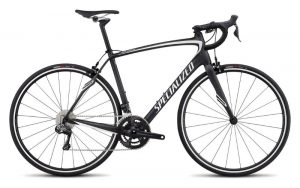
Road bikes are all about speed and performance. Their target is to be the quickest bike possible. A road bike is commonly used by the avid rider who primarily uses their bike for long rides, races, or frequent workouts.
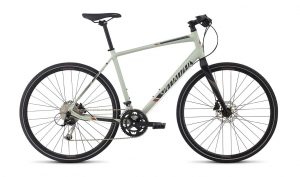
Hybrid bikes are the hybrid between a road bike and a mountain bike. They take characteristics from both bikes in order to create a bike designed for people who want the best of both worlds. A hybrid has the speed of a road bike with the comfort of a mountain bike. A hybrid is commonly used by the recreational rider who primarily uses their bike for commuting, touring, or the occasional workout.
It should be noted that this does not mean it is foolish to use a road bike or a hybrid bike for purposes that the other is more suited for. It is certainly common for riders’ needs and interests to overlap across the purposes of both road bikes and hybrids. For this reason, a deeper investigation into both bikes is prudent in order to discover which bike is best for you.
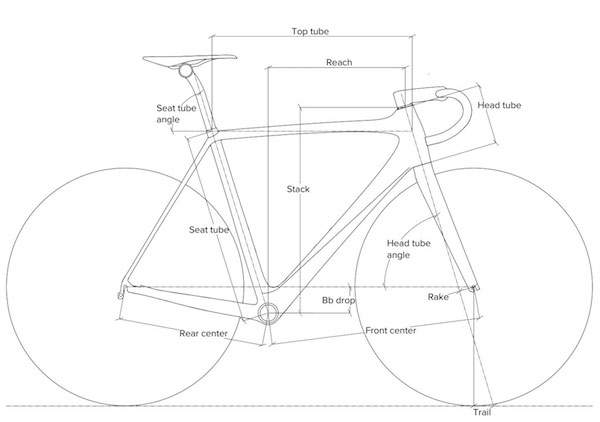
Road Bike and hybrid Frame Geometry
Hybrids are designed for casual and comfortable upright riding, and so their frames reflect that. With a shorter top tube and shorter reach from the saddle to the handlebars compared to that of a road bike, a hybrid feels shorter and more upright than a road bike, not just in ride feel but in the actual frame geometry. A hybrid’s frame is designed to keep most of the rider’s weight on the saddle; whereas a road bike's distributes the rider’s weight more evenly from the handlebars and front wheel, to the saddle and the rear wheel.
Road bikes are designed for speed, which benefits from a low and narrow aerodynamic position. A road bike frame has a longer top tube and longer reach compared to a hybrid, which causes a longer and lower rider position.
Road Bike and hybrid Performance
Road bikes are typically much more performance-driven than hybrid bikes. In order for a bike to achieve optimal speed, the weight of the frame plays a big part. The industry standard for building the lightest bikes is to construct carbon fiber frames. While aluminum bike frames are only a half-pound to a pound heavier, that marginal difference can go a long way.
Both hybrids and road bikes can be built with carbon or aluminum frames but you’ll find that a majority of road bikes are built with carbon and a majority of hybrids are built with aluminum or steel. Due to the high cost of manufacturing a carbon fiber frame road bikes tend to be more expensive than hybrids. This is by no means the only reason why road bikes are pricier. We’ll cover a few more reasons why road bikes are on the higher-end side and why hybrid bikes tend to be more budget-friendly.
Road Bike Aero and hybrid Aerodynamics
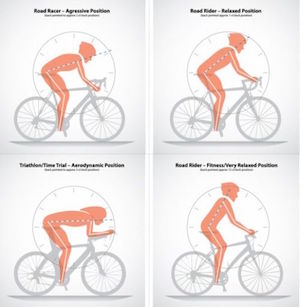
A bike rider’s aerodynamics are a bi-product of a bike’s geometry and a contributor to a bike’s performance. This connection to geometry and performance points to why road bikes are more aero than hybrid bikes. When seated on a road bike the rider’s back is angled lower and closer to the bike whereas on a hybrid bike the rider’s back is slightly more upright. One of the quickest ways to distinguish a hybrid bike from a road bike is by looking at the handlebars. Road bikes are usually equipped with drop bars giving the rider 3 options for where to place their hands. Hybrids on the other hand almost always have flat bars giving the rider just 1 option for where they can place their hands.
Road Bike and hybrid Comfort
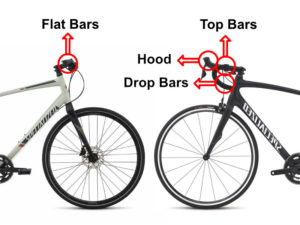
As you might have guessed based on the geometry of a road bike vs hybrid bike, the hybrid wins the comfort battle. Although the seat is something on a bike that can be easily replaced or customized it still plays a small role when choosing the right bike. Hybrids typically come with a larger seat with more cushion whereas a road bike seat will aim to be both comfortable and minimalistic. More importantly than the seat however is how the geometry and handlebars of the hybrid make it a more comfortable ride.
A hybrid’s geometry is more compact than a road bike’s, allowing the bike rider to sit more upright. If your lower back is not accustomed to arching over then a hybrid might be the better call. The same goes for the difference in their handlebars. Hybrids typically come with flat bars making the stability and turning easy and comfortable. Whereas the drop bars commonly found on a road bike can be challenging to stabilize for novice cyclists. The flip side is that drop bars do allow road bikes to be more versatile and more agile.
Road Bike and hybrid Rim & Disc Brakes
We are now in an age of bike evolution where disc brakes are kicking rim brakes to the curb. Rim brakes have been on bikes for centuries, whereas disc brakes have only hit the scene within the last few decades. Hybrids and road bikes offer both braking systems, but disc brakes are becoming more and more popular for both styles of bike. Despite this trend, there are still a handful of benefits to the classic rim brakes. Rim brakes are lighter, great for riders that prioritize less weight for higher speeds. They are also easier to replace and maintain making road-side fixes and bike shop maintenance quicker, simpler, and cheaper. The only pitfalls, when compared to disc brakes, are that they are not as strong and not as durable in wet climates.
Road Bike and hybrid Wheels and tyres
Both road bikes and hybrids use standard 700c road wheel sizes to fit their frames and create the best balance between speed, handling, and comfort. Some hybrids may have slightly larger or wider wheels, and these are meant for more committed off-road riding. Mountain bike wheels share the same trait, with the extra size and width making them stronger and more durable over rough terrain.
When it comes to tyres, road bikes use tyres that are lighter, narrower, and thinner than hybrids. This is all directly correlated to speed, as best road bike tyres are designed to be as fast as possible. With little tread – the grooves and markings along the tyre’s surface – road tyres are fast on tarmac, but slippery on any off-road surface. Most road tyres are between 21mm and 38mm wide, with most roadies opting for tyres that are either 25mm or 28mm wide. Road tyres are much lighter and faster than hybrid tyres, although they are significantly less durable. Hybrid tyres are thicker, heavier, and wider than road tyres, which makes them better protected against punctures. Most hybrid tyres are over 32mm wide, and up to 38mm or even 40mm will fit in most hybrid frames.
Hybrid tyres have a wide range of treads available, and you can choose one based on your desired ride terrain. For city-going commuters, a slick hybrid tyre or smooth file tread will be the best commuting bike tyre option. But for hybrid riders who want to explore a little bit of off-roading, they can opt for a thicker hybrid tyre with more tread overall and especially on the sides of the tyres for slippery corners. Hybrid tyres are heavy and slow compared to road tyres, but they are also better on variable terrain, puncture-resistant, and handle better in the wet.
Road Bike and hybrid Handlebars
One of the defining features of road bikes versus hybrids is that they use drop bars instead of flat bars. Drop bars are carefully curved handlebars that offer three different hand positions for the rider: on the hoods, on the tops, or in the drops. The hoods are on the front of their drop bars – where you can also find the braking and shifting levers – and this is the most comfortable and common position for road riding. The tops are typically used for climbing, whereas the drops are used for descending, sprinting and cornering.
Hybrid bikes use flat bars which, like mountain bike handlebars, extend from left to right with only a few degrees of curvature in the middle. On mountain bikes, there is only one hand position, and that is at either end of the flat handlebar, but some hybrids have an added piece to their handlebars called ‘bull horns.’ These are curved extensions on the end of the flat bar that can be used as a second-hand position. This is a feature of hybrids that we really don’t see on any other style of bike.
Hybrids also use different brake levers shifters compared to road bikes – as you could’ve guessed, most hybrids borrow the style of shift and brake levers from mountain bikes as they both use similarly shaped flat bars. Instead of the vertical levers on road bike hoods, hybrids use thumb and finger shifters, and separate pull-levers for their brakes.
Most road bike drop handlebars measure between 38cm and 44cm wide, while hybrid bars are significantly wider at 52cm to 70cm wide.
Road Bike and hybrid Speeds
The speeds (or gears) on a road bike and hybrid are marginally distinguishable. Because road bikes attempt to be as light as possible they traditionally have fewer speeds than hybrids. They’re able to shed some weight by only having two chainrings in front behind the cranks, unlike many hybrids that boast three chainrings in the front. This slightly larger spread of speeds allows some hybrids to be better prepared for long journeys that vary widely in terrain. This being said, many hybrids are beginning to adopt a road bike style gear setup up because the few extra speeds are so rarely needed.
Road Bike and hybrid Mechanical & Electronic Shifting
If you’re leaning towards a hybrid bike you can almost certainly count on it having the traditional mechanical shifting. Electronic shifting is a more expensive set up more commonly reserved for road bikes. Although it is not impossible to see electronic shifting on a hybrid bike it is extremely rare. The primary pitfall of mechanical shifting is cables stretching and fraying over time, causing the shifting to be thrown out of whack.
The benefits of upgrading to electronic shifting include more reliability, shifting accuracy, and less maintenance over time. When wires replace cables you have less wear and tear and therefore more reliable shifting. Because electronic shifting is programmed the derailleur is robotically accurate, allowing for a smooth changing of gears. While all of this means you won’t have to worry about adjusting cable tension and replacing cables, it does require a more seasoned mechanic to make fixes. This inevitably incurs higher spending on bike shop maintenance when it comes to getting the shifting checked out.
Summary of Hybrid Bikes Vs. Road Bikes
In a nutshell, road bikes mostly appeal to those who seek speed and endurance for long-distance rides without worrying about getting off the roads. The bike’s geometry and lightweight design allows for maximum efficiency and greater speed. Plus the riding position is forward-leaning owing to the dropped handlebars allowing for constant speed and efficiency on the road. Hybrid bikes offer the best of both the worlds – a mix of features of both road bikes and mountain bikes. They are the premium line of bicycle designs that particularly appeal to bike commuters or for casual-paced pedaling around town.